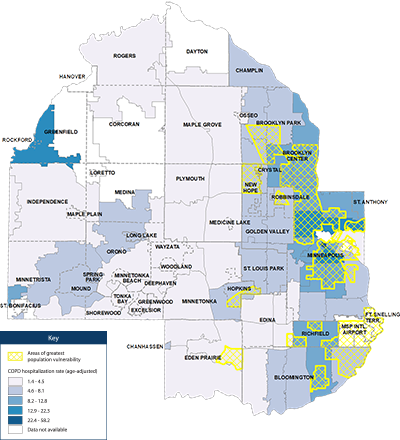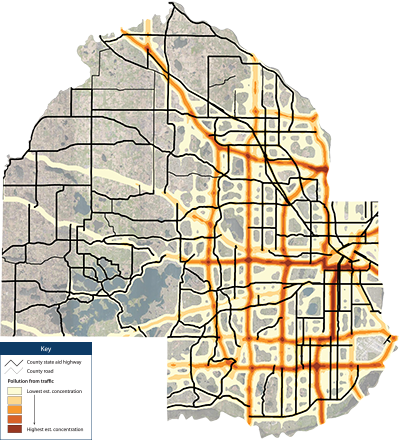Air quality
Causes and trends
 Rising temperatures and changes in climate patterns are likely to increase air pollution, resulting in decreased air quality that will make underlying health conditions worse.
Rising temperatures and changes in climate patterns are likely to increase air pollution, resulting in decreased air quality that will make underlying health conditions worse.
Currently, Hennepin County’s air quality is generally good in terms of meeting federal air quality standards. Air quality has improved in recent years due to several factors. Many power plants have transitioned to using natural gas instead of coal, solar and wind energy has increased, there are more transit options, and fuel economy standards have increased.
However, projected climate trends will result in decreased air quality.
Impacts and threats
Increasing levels of air pollution pose threats to those with underlying health conditions such as asthma, chronic obstructive pulmonary disease (COPD), and allergies. The impacts of increased air pollution include:
- Unhealthy air quality from increasing levels of ozone and particulate matter and more days affected by wildfire smoke.
- More mold and bacterial growth in buildings due to rising humidity levels and more frequent flooding.
- Extended allergy season due to rising temperatures and the lengthening of the growing season.
Who is more at risk
Some people are exposed to more air pollution than others because of where they live or work, and some people are more affected by.
For example, people with pre-existing heart and lung conditions are at greater risk, and so are the elderly and children.
People of color, indigenous people, and people with low incomes face social, economic, and health inequities that often contribute to increased frequency of health conditions that can be affected by air pollution.
Air pollution tends to be higher in the parts of Hennepin County where residents who are most susceptible to climate change live because of the higher density of emission sources. For example, transportation-related air pollution is higher in the more urban areas of the county where the road network is densest and traffic is highest. This coincides where many of the residents most susceptible to climate change live.
See the Minnesota Pollution Control Agency's Life and Breath report (PDF) for more information on how air pollution affects health in Minnesota.

